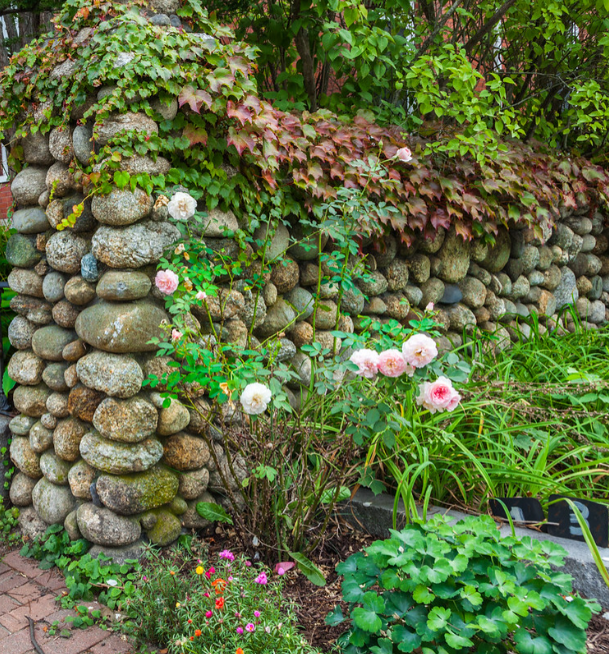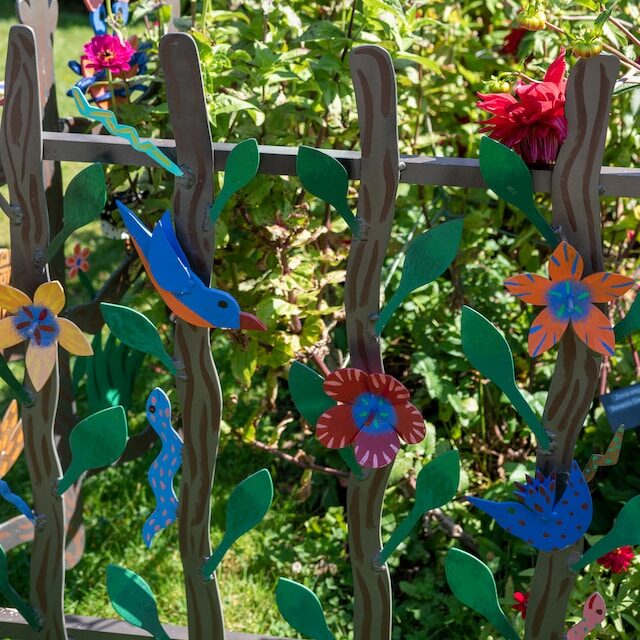There’s a variety of fences that will work in a cottage garden, from rustic to modern designs. There’s also many different materials choose from. Depending on your budget, there are DIY options that will keep the price down, while still putting that finishing touch to your garden. Read on for some interesting cottage fence ideas.
History and Evolution of Cottage Fences
They originated in the English countryside, where cottagers would use whatever materials were at hand to mark their property boundaries. This often meant using stones, branches, or woven willow wands. The result was a rustic, charming fence that was as practical as it was picturesque.
Over time, as materials became more accessible and design trends evolved, so did cottage fences. They became more than just a boundary marker; they became a statement of personal style and a key element in landscape design.
Types of Cottage Fences

Here’s some of the more common fence styles that you will find in your traditional cottage garden…
- Wooden Fences: These are a classic choice for cottage gardens. They can be painted or stained to match your garden’s color scheme. Picket fences, in particular, are a quintessential feature of cottage style.
- Wrought Iron Fences: These offer a more formal, yet equally charming, option. They’re durable, elegant, and can be adorned with intricate designs.
- Stone or Brick Walls: These can provide a rustic, sturdy boundary that blends seamlessly with the natural landscape.
- Bamboo or Willow Fences: These are perfect for a more eco-friendly, natural look. They’re also great for adding a touch of the exotic to your garden. Keep an eye out down below for our simple instructions on how to build a willow fence
As for designs, the sky’s the limit! You can opt for a traditional picket fence, a lattice design for climbing plants, or a modern horizontal slat design for a contemporary twist.
Choosing the Right Fence for Your Garden or Yard
Here are some factors to consider when choosing what fence will suit your garden:
Size: The size of your garden or yard will influence the height and length of your fence. A small garden might benefit from a low fence to keep it open and inviting, while a large yard might need a taller fence for privacy.
Privacy Needs: If you’re looking to create a secluded haven, a solid fence design might be your best bet. If you’re not concerned about privacy, a picket or lattice fence can add charm without blocking views.
Security: If keeping pets in or wildlife out is a priority, consider a sturdy fence with secure gates.
Budget: Fencing can range from inexpensive (think split-rail or chain link) to high-end (think wrought iron or custom wood). Choose a material and design that fits your budget.
Ideas for Decorating and Painting Cottage Fences

Decorating and painting your cottage fence can be a delightful way to add personality to your garden.
Decorating Ideas: Consider hanging flower pots, birdhouses, or wind chimes on your fence. You could also grow climbing plants like roses or ivy for a natural decoration. For a whimsical touch, you could paint a mural or hang some garden-themed artwork.
Choosing the Right Paint: Choose a color that complements your home and garden. Classic white is always a safe bet, but don’t be afraid to go bold with blues, greens, or even yellows.
Design Tips: Consider painting your fence in a pattern, like stripes or chevrons, for a unique look. Or, you could paint the fence posts a different color for a pop of contrast.
🏡 Boundary Brief: Use solar lights to illuminate your fence at night. 🏡
DIY Projects for Cottage Fences
For those of you who love a good DIY project, a cottage fence offers a canvas for creativity. Here’s a few ideas to get you started:
Pallet Fence: With some wooden pallets, a bit of elbow grease, and a splash of paint, you can create a charming and cost-effective fence.
🏡 Fence Fancy: Repurpose old doors or windows for a unique fence. 🏡
Birdhouse Fence: Attach birdhouses to your fence posts for a delightful touch that also invites feathered friends into your garden.
Planter Fence: Attach planters or mason jars to your fence and fill them with your favorite flowers or herbs for a vertical garden.
Willow Fence

Below is a simplified guide on how to build a charming willow fence for a cottage garden. This natural, eco-friendly fencing option not only adds aesthetic appeal but also provides a functional boundary. The process involves preparing the site, ordering and inserting willow rods, weaving them into a pattern, and maintaining the fence.
Materials Needed:
- Willow rods
- Compost
- Mulch
- Garden twine
- Screwdriver or dowel rod
- Hand pruners
- Stakes
Instructions:
- Prepare the Site: Choose a sunny, moisture-retentive area. Clear grass and weeds, loosen the soil about 10 inches deep, and mix in compost.
- Order Willow Rods: Purchase 6-foot or longer willow rods from specialist growers.
- Mark the Fence Row: Place stakes at each end of your intended fence line with garden twine stretched between them.
- Prepare Holes: In spring, make holes in the soil about 8 inches deep and 10 inches apart.
- Insert Willow Rods: Insert half the willow stems in the ground at 45-degree angles. Then insert the other half of the stems in between, angled the opposite direction, to create a diamond pattern. Tie some joints together with garden twine for stability.
- Add Mulch: Mulch the ground around the stems to conserve moisture and suppress weeds.
- Weave the Willow: As the willow grows, train the new growth into the existing design. Weave the rods into a diamond lattice pattern.
- Secure and Trim Willow: Tie wayward rods in place with garden twine. Trim the ends and tops of the rods to make the fence orderly. Remove the twine after 4-6 weeks.
- Maintain the Fence: Trim the branches that develop as the rods leaf out to keep the lattice open, or weave them back into the lattice for a denser fence. Regular pruning and trimming are necessary to maintain the fence.
